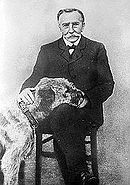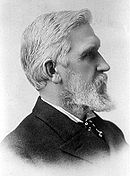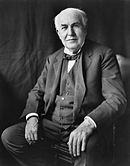1844 to 1875
- 1844: Innocenzo Manzetti first mooted the idea of a “speaking telegraph” (telephone).
- 1849: Antonio Meucci demonstrates a communicating device to individuals in Havana. It is disputed if this is an electromagnetic telephone, but is said to involve direct transmission of electricity into the user's body.
- 1854: Charles Bourseul publishes a description of a make-break telephone transmitter and receiver in L'Illustration, (Paris) but does not construct a working instrument
- 1854: Antonio Meucci demonstrates an electric voice operated device in New York, but it is not clear what kind of device he demonstrated.
- 1860: Johann Philipp Reis of Germany demonstrates a make-break transmitter after the design of Bourseul and a knitting needle receiver. Witnesses said they heard human voices being transmitted.
- 1861: Johann Philipp Reis manages to transfer voice electrically over a distance of 340 feet, see Reis' telephone.
- 1864: in an attempt to give his musical automaton a voice, Innocenzo Manzetti invents the 'Speaking telegraph'. He shows no interest in patenting his device, but it is reported in newspapers.
- 1865: Meucci reads of Manzetti's invention and writes to the editors of two newspapers claiming priority and quoting his first experiment in 1849. He writes "I do not wish to deny Mr. Manzetti his invention, I only wish to observe that two thoughts could be found to contain the same discovery, and that by uniting the two ideas one can more easily reach the certainty about a thing this important." If he reads Meucci's offer of collaboration, Manzetti does not respond.
- 1871: Antonio Meucci files a patent caveat (a statement of intention to patent)[1] for a Sound Telegraph, but it does not describe an electromagnetic telephone.
- 1872: Elisha Gray founded Western Electric Manufacturing Company.
- 1872: Professor Vanderwyde demonstrated Reis's telephone in New York.
- July 1873: Thomas Edison notes variable resistance in carbon grains due to pressure, builds a rheostat based on the principle but abandons it because of its sensitivity to vibration.
- May 1874: Gray invents electromagnet device for transmitting musical tones. Some of his receivers use a metallic diaphragm.
- 29 December 1874: Gray demonstrates his musical tones device and transmitted "familiar melodies through telegraph wire" at the Presbyterian Church in Highland Park, Illinois.
- 2 June 1875: Alexander Graham Bell transmits the sound of a plucked steel reed using electromagnet instruments.
- 1 July 1875: Bell uses a bi-directional "gallows" telephone that was able to transmit "indistinct but voicelike sounds" but not clear speech. Both the transmitter and the receiver were identical membrane electromagnet instruments.
- 1875: Thomas Edison experiments with acoustic telegraphy and in November builds an electro-dynamic receiver but does not exploit it.
1876 to 1878
- 11 February 1876: Elisha Gray invents liquid transmitter for use with a telephone, but does not build one.
- 14 February 1876: (about 9:30am) Gray or his lawyer brings to the Washington, D.C. patent office Gray's caveat for the telephone. (A caveat was like a patent application without claims to notify the patent office of an invention in process.)
- 14 February 1876: (about 11:30am) Bell's lawyer brings to the same patent office Bell's patent application for the telephone. Bell's lawyer requested that it be registered immediately in the cash receipts blotter.
- 14 February 1876: (about 1:30pm) Approximately two hours later Elisha Gray's caveat was registered in the cash blotter. Although his caveat was not a full application, Gray could have converted it into a patent application, but did not do so because of advice from his lawyer and his involvement with acoustic telegraphy. The result was that the patent was awarded to Bell.[2]
- 7 March 1876: Bell's US patent No. 174,465 for the telephone is granted.
- 10 March 1876: Bell transmits speech "Mr. Watson, come here! I want to see you!" using a liquid transmitter as described in Gray's caveat, and an electromagnetic receiver.
- 16 May 1876: Thomas Edison files first patent application for acoustic telegraphy for which US patent 182,996 was granted October 10, 1876.
- 10 August 1876: Alexander Graham Bell makes the world's first long distance telephone call, about 6 miles between Brantford and Paris, Ontario, Canada.
- 1876: Hungarian Tivadar Puskas invented the telephone switchboard exchange (later working with Edison).
- 9 October 1876: Bell makes the first two-way long distance telephone call between Cambridge and Boston, Massachusetts, USA.
- October 1876: Thomas Edison tests his first carbon microphone.
- January 1878: First North American telephone exchange is opened in New Haven, Connecticut.
- 20 January 1877: Edison "first succeeded in transmitting over wires many articulated sentences" using carbon granules as a pressure sensitive variable resistance under the pressure of a diaphragm (Josephson, p143).
- 30 January 1877: Bell's US patent No. 186,787 is granted for an electro-magnetic telephone using permanent magnets, iron diaphragms, and a call bell.
- 4 March 1877: Emile Berliner invents a microphone based on "loose contact" between two metal electrodes, an improvement on the Reis' Telephone, and in April 1877 files a caveat of an invention in process.
- April 1877: A telephone line connects the workshop of Charles Williams, Jr., located in Boston, to his house in Somerville, Massachusetts at 109 Court Street in Boston, where Alexander Graham Bell and Thomas Watson had previously experimented with their telephone. The telephones became No. 1 and 2 in the Bell Telephone Company.[3]
- 27 April 1877: Thomas Edison files telephone patent application. The US patents (Nos. 474,230, 474,231 and 474,232) were awarded to Edison in 1892 over the competing claims of Alexander Graham Bell, Emile Berliner, Elisha Gray, A E Dolbear, J W McDonagh, G B Richmond, W L W Voeker, J H Irwin and Francis Blake Jr.[4] Edison's carbon granules transmitter and Bell's electromagnetic receiver were used, with improvements, by the Bell system for many decades thereafter (Josephson, p 146).
- 4 June 1877: Emile Berliner files telephone patent application that includes a carbon microphone transmitter.
- 9 July 1877: Bell Telephone Company, a common law joint stock company, organized by Alexander Graham Bell's future father-in-law Gardiner Greene Hubbard.
- 1 December 1877: Western Union enters the telephone business using Thomas Edison's superior carbon microphone transmitter.
- 4 February 1878: Thomas Edison demonstrates the telephone between Menlo Park, New Jersey and Philadelphia, a distance of 210 km.
- 14 June 1878: The Telephone Company Ltd (Bell's Patents) registered, London. Opened in London 21 August 1879 - Europe's first telephone exchange.
- 12 September 1878: the Bell Telephone Company sues Western Union for infringing Bell's patents.
1879 to 1919
- early months of 1879: The Bell Telephone Company is near bankruptcy and desperate to get a transmitter to equal Edison's carbon transmitter.
- 17 February 1879: Bell Telephone merges with the New England Telephone Company to form the National Bell Telephone Company. Theodore Vail takes over operations.
- 1879: Francis Blake invents a carbon transmitter similar to Edison's that saves the Bell company from extinction.
- 2 August 1879: The Edison Telephone Company of London Ltd, registered. Opened in London 6 September 1879.
- 10 September 1879: Connolly and McTighe patent a "dial" telephone exchange (limited in the number of lines to the number of positions on the dial.).
- 19 February 1880: The photophone, also known as a radiophone, is invented jointly by Alexander Graham Bell and Charles Sumner Tainter at Bell's Volta Laboratory.[5][6] The device allowed for the transmission of sound on a beam of light.
- 20 March 1880: National Bell Telephone merges with others to form the American Bell Telephone Company.
- 1 April 1880: world's first wireless telephone call on Bell and Tainter's photophone (distant precursor to fiber-optic communications) from the Franklin School in Washington, D.C. to the window of Bell's laboratory, 213 meters away.[7][8]
- 1882: A telephone company—an American Bell affiliate—is set up in Mexico City.
- 1885: The American Telephone & Telegraph Company (AT&T) is formed.
- 1886: Gilliland's Automatic circuit changer is put into service between Worcester and Leicester featuring the first operator dialing allowing one operator to run two exchanges.
- 13 January 1887: the Government of the United States moves to annul the master patent issued to Alexander Graham Bell on the grounds of fraud and misrepresentation. The case, known as the 'Government Case', is later dropped after it was revealed that the U.S. Attorney General, Augustus Hill Garland had been given millions of dollars of stock in the company trying to unseat Bell's telephone patent.
- 1888: Telephone patent court cases are confirmed by the Supreme Court, see The Telephone Cases
- 1889: AT&T becomes the overall holding company for all the Bell companies.
- 2 November 1889: A. G. Smith patents a telegraph switch which provides for trunks between groups of selectors allowing for the first time, fewer trunks than there are lines, and automatic selection of an idle trunk.
- 10 March 1891: Almon Strowger patents the Strowger switch the first Automatic telephone exchange.
- 30 October 1891: The independent Strowger Automatic Telephone Exchange company is formed.
- 3 May 1892: Thomas Edison awarded patents for the carbon microphone based on applications lodged in 1877.
- 3 November 1892: The first Strowger switch goes into operation in LaPorte, Indiana with 75 subscribers and capacity for 99.
- 30 January 1894: The second fundamental Bell patent for the telephone expire; Independent telephone companies established, and independent manufacturing companies (Stromberg-Carlson in 1894 and Kellogg Switchboard & Supply Company in 1897).
- 30 December 1899: American Bell Telephone Company is purchased by its own long-distance subsidiary, American Telephone and Telegraph (AT&T) to bypass state regulations limiting capitalization. AT&T assumes leadership role of the Bell System.
- 27 February 1901: United States Court of Appeal declares void Emile Berliner's patent for a telephone transmitter used by the Bell telephone system
- 1915: First U.S. coast-to-coast long-distance telephone call, facilitated by a newly-invented vacuum tube amplifier, ceremoniously inaugurated by A.G. Bell in New York City and his former assistant Thomas Augustus Watson in San Francisco, California.
- 16 January 1915: The first automatic Panel exchange was installed at the Mulberry Central Office in Newark, New Jersey; but was a semi-automatic system using non-dial telephones.
- 25 January 1915: The first transcontinental telephone call, with Thomas Augustus Watson at 333 Grant Avenue in San Francisco receiving a call from Alexander Graham Bell at 15 Dey Street in New York City.[9]
- 1919: The first rotary dial telephones in the Bell System installed in Norfolk, Virginia. Telephones that lacked dials and touch-tone pads were no longer made by the Bell System after 1978.[citation needed]
- 1919: AT&T conducts more than 4,000 measurements of people's heads to gauge the best dimensions of standard headsets so that callers' lips would be near the microphone when holding handsets up to their ears.[10]
1920 to 1969
- 7 January 1927: first public trans-Atlantic telephone call via radio; May 12 from
- 7 April 1927: world's first videophone call via an electro-mechanical AT&T unit, from Washington, D.C. to New York City, by then-Commerce Secretary Herbert Hoover.[11][12]
- 28 May 1927: Rotary dial service was started from mid night.[1]
- 1935: first telephone call around the world.
- 1941: Multi-frequency dialing introduced for operators in Baltimore, Maryland
- 1946: National Numbering Plan (area codes)
- 1946: first commercial mobile phone call
- 1946: Bell Labs develops the germanium point-contact transistor
- 1947: December, W. Rae Young and Douglas H. Ring, Bell Labs engineers, proposed hexagonal cells for mobile phones.
- 1948: Phil Porter, a Bell Labs engineer, proposed that cell towers be at the corners of the hexagons rather than the centers and have directional antennas pointing in 3 directions.
- 1951: Direct Distance Dialing (DDD) first offered at Englewood, New Jersey, to 11 selected major cities across the United States; this service grew rapidly across major cities during the 1950s
- 1955: the laying of trans-Atlantic cable TAT-1 began - 36 circuits, later increased to 48 by reducing the bandwidth from 4 kHz to 3 kHz
- 1958: Modems used for direct connection via voice phone lines
- 1960: ESS-1
- 1960's: Bell Labs developed the electronics for cellular phones
- 1961: Touch-tone released to public on trial basis
- 1962: T-1 service in Skokie, Illinois
- 1963: first publicly-available push-button telephone was released, by Bell Systems/Western Electric, in the towns of Carnegie and Greensburg, Pennsylvania.
- 1965: first geosynchronous communications satellite - 240 circuits or one TV signal
1970 to 1999
- 1970: ESS-2 electronic switch.
- 1970: modular telephone cords and jacks introduced .
- 1970: Amos E. Joel, Jr. of Bell Labs invented the "call handoff" system for "cellular mobile communication system" (patent granted 1972).
- 1971: AT&T submitted a proposal for cellular phone service to the U.S. Federal Communications Commission (FCC).
- 3 April 1973: Motorola employee Martin Cooper placed the first hand-held cell phone call to Joel Engel, head of research at AT&T's Bell Labs, while talking on the first Motorola DynaTAC prototype.
- 1973: packet switched voice connections over ARPANET with Network Voice Protocol (NVP).
- 1978: Bell Labs launched a trial of the first commercial cellular network in Chicago using Advanced Mobile Phone System (AMPS).
- 1978: World's first NMT phone call in Tampere, Finland.[13]
- 1979: VoIP - NVP running on top of early versions of IP
- 1981: The world's first fully-automatic mobile phone system NMT is started in Sweden and Norway.
- 1981: BT introduces the British Telephone Sockets system.
- 1982: FCC approved AT&T proposal for AMPS) and allocated frequencies in the 824-894 MHz band.
- 1982: Caller ID patented by Carolyn Doughty, Bell Labs
- 1983: last manual telephone switchboard in Maine is retired
- 1984: AT&T completes the divestiture of its local operating companies. This forms a new AT&T (long distance service and equipment sales) and the Baby Bells.
- 1987: ADSL introduced
- 1988: First transatlantic fiber optic cable TAT-8, carrying 40,000 circuits
- 1990: analog AMPS was superseded by Digital AMPS.
- 1991: the GSM mobile phone network is started in Finland, with the first phone call in Tampere.[13]
- 1993: Telecom Relay Service available for the disabled
- 1995: Caller ID implemented nationally in USA
- 1999: creation of the Asterisk Private branch exchange
2000 to 2010
- 11 June 2002: Antonio Meucci recognized for his work on the telephone by the United States House of Representatives, in House Resolution 269. The Parliament of Canada responds by passing a motion unanimously 10 days later recognizing Alexander Graham Bell as the inventor of the telephone.
- 2005: Mink, Louisiana gets phone service (one of the last in the USA).
- 29 June 2007: The iPhone started shipping
- July 2007: The Openmoko Neo 1973 started shipping[14]
- 24 June 2008: The Neo 1973 successor, the Neo FreeRunner, started shipping
- 24 June 2008 : The Symbian Foundation was founded [15]
- 22 October 2008: The first Android phone, the HTC Dream started shipping
- November 2009: The Nokia N900 started shipping
- 2010: Iowa Hill, California gets phone service (another one of the last in the USA).
- 15 February 2010: Symbian^3, the first fully open source version of Symbian is released[16]















